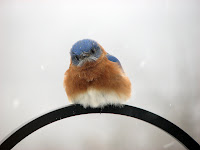 Some of the most colorful, most beautiful pictures that I have taken in nature were taken this time of year. With the right timing and circumstances you can see those colors too.
Some of the most colorful, most beautiful pictures that I have taken in nature were taken this time of year. With the right timing and circumstances you can see those colors too.Sunrises and sunsets seem their brightest on a cold winter’s morning or evening. Beautiful orange and red sunrises and sunsets are caused by dust particles scattering the sunlight into its composite colors. Tiny particles in the air usually create orange colors. Larger particles create reds, due to the way the light bends and scatters. If you live in a large city or industrial area you are most likely to see red sunsets because pollution particles are larger. We mostly see orange around here. You don’t see the blues and violets in sunrises or sunsets because those shorter wavelength colors get scattered. I get more pictures of sunrises because my view to the east is unobstructed by houses. But, supposedly, beautiful sunsets are more common than sunrises because there is more dust in the air at the end of the day than at the beginning. Clouds above the horizon, but not blocking the sun, reflect the colors and make the scene more dramatic.
 Rainbows. There is nothing like a beautiful rainbow to raise your spirits and get everyone excited. We have all seen rainbows, and here are some facts to help you spot more.
Rainbows. There is nothing like a beautiful rainbow to raise your spirits and get everyone excited. We have all seen rainbows, and here are some facts to help you spot more.Rainbows are formed when water droplets (rain) reflect and bend regular sunlight into the multiple colors that form all light. When the colors are blended together you see normal light. But when rain reflects and refracts the light you can see the separate colors. To see a rainbow the sun must be at your back and the rain in front of you. It needs to be raining in one part of the sky and the sun needs to be shining in another part. Most rainbows happen in the afternoon towards the east. The lower the sun is in the sky, the higher the rainbow. That is a law of physics. Rare double rainbows happen when conditions are just right and the light is reflected twice by the water droplets. The secondary rainbow will be just above the primary rainbow, and, the colors will be reversed.
Just about every culture and religion has legends and myths about rainbows. To some cultures, a rainbow signifies war. To others it is peace or a bridge to heaven. One Bulgarian legend says that if a person passes under a rainbow that their thinking will change gender. In other words, a man will start thinking like a woman…now that is a scary thought. And, by the way, the pot of gold theory doesn’t really work, I tried it.
 One last bright beautiful color this time of year that I can’t fail to mention is blue. Male bluebirds are about as bright blue right now as they will be all year. If you have them around you know what I mean.
One last bright beautiful color this time of year that I can’t fail to mention is blue. Male bluebirds are about as bright blue right now as they will be all year. If you have them around you know what I mean.Usually we think of winter as being dull, grey, brown, and pretty colorless. But winter can have some of the most vivid colors of the year. Watch for them. Your winter will be brighter.






